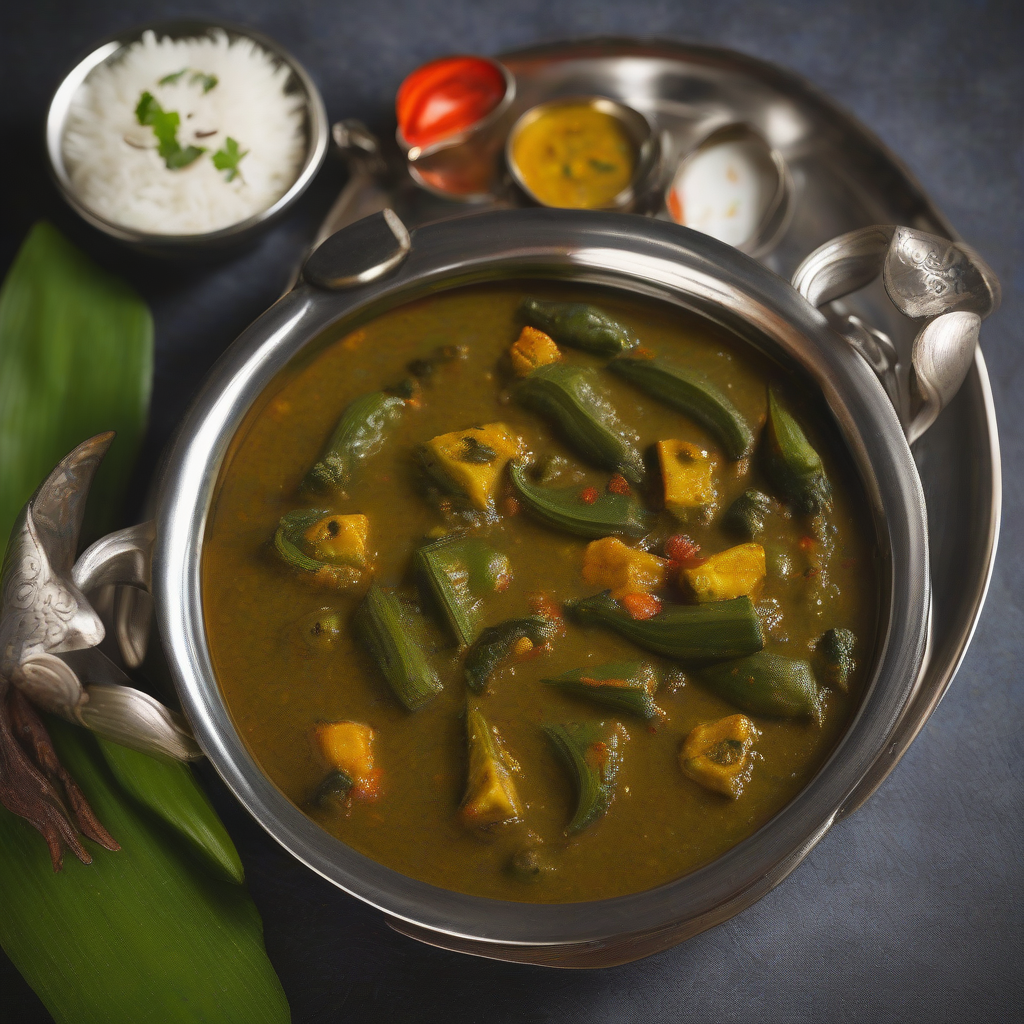Bhindi Sambhar: A Taste of Home, Oye!
Namaste Doston! Kem cho? Assalamualaikum! Sat Sri Akal! Chef Curry Do’pyaza here, back with another delicious dish that’ll transport you straight to the heart of South India! Today, we’re diving into the wonderful world of Bhindi Sambhar, a tangy, flavorful, and oh-so-satisfying lentil stew featuring our favorite green veggie – bhindi (okra)!
This dish is a staple in many South Indian homes, especially in Tamil Nadu, Karnataka, and Andhra Pradesh. It’s a regular at festive gatherings like Pongal, Ugadi, and Diwali, adding a comforting warmth to the celebrations. It’s also a fantastic everyday meal, perfect for a light lunch or a comforting dinner, especially during the cooler months when a warm bowl of sambhar feels like a hug from the inside.
A Little History Lesson (Don’t worry, it’s short!)
Sambhar itself has a fascinating story! Legend says it originated in the kitchens of the Thanjavur Maratha rulers in Tamil Nadu. Apparently, a cook trying to recreate a lentil dish called “Amti” accidentally added tamarind pulp, creating the tangy base we know and love today. Over time, different vegetables were added, and voila! Sambhar was born. Bhindi Sambhar is simply one delicious variation of this iconic dish.
Let’s Get Cooking!
Preparation Time: 15 minutes
Cooking Time: 30 minutes
The Good Stuff (Ingredients)
- 1 cup Toor Dal (Split Pigeon Peas)
- 2 cups Bhindi (Okra), cut into 1-inch pieces
- 1 medium Onion, chopped
- 2 medium Tomatoes, chopped
- 2 Green Chilies, slit lengthwise (adjust to your spice level!)
- 1 tbsp Sambhar Powder (store-bought or homemade)
- 1 tsp Turmeric Powder (Haldi)
- 1/2 tsp Red Chili Powder (Lal Mirch) (optional, for extra heat)
- 1/2 tsp Mustard Seeds (Rai)
- 1/2 tsp Cumin Seeds (Jeera)
- A pinch of Asafoetida (Hing)
- 1 sprig Curry Leaves (Kadi Patta)
- 1 tbsp Tamarind Paste (Imli) or soak a small ball of tamarind in warm water and extract the pulp.
- 2 tbsp Vegetable Oil
- Salt to taste
- Fresh Coriander Leaves (Hara Dhaniya), for garnish
Step-by-Step: From Kitchen Novice to Sambhar Superstar!
- Dal Prep: Wash the toor dal thoroughly and pressure cook it with 2 cups of water and a pinch of turmeric powder until it’s soft and mushy. About 3-4 whistles should do the trick. Once cooked, mash the dal lightly with a spoon.
- Bhindi Magic: Heat 1 tablespoon of oil in a pan. Add the chopped bhindi and sauté it on medium heat until it’s slightly browned and the sliminess disappears. This usually takes about 5-7 minutes. Set aside.
- The Tadka (Tempering): In the same pan, heat the remaining 1 tablespoon of oil. Add mustard seeds. Once they start to splutter, add cumin seeds, asafoetida, and curry leaves. Let them sizzle for a few seconds. This fragrant tadka is the soul of the sambhar!
- Veggie Power: Add the chopped onions and green chilies to the pan and sauté until the onions turn translucent. Then, add the chopped tomatoes and cook until they soften and become pulpy.
- Spice It Up!: Add the sambhar powder, turmeric powder, and red chili powder (if using) to the pan. Sauté for a minute, stirring constantly, to release their aroma. Be careful not to burn the spices!
- Combine and Simmer: Add the cooked dal, sautéed bhindi, and tamarind paste (or tamarind pulp) to the pan. Add 1-2 cups of water, depending on the desired consistency. Bring the sambhar to a boil, then reduce the heat and simmer for 15-20 minutes, allowing the flavors to meld together beautifully.
- Season and Serve: Add salt to taste. Garnish with fresh coriander leaves. Your Bhindi Sambhar is ready to be devoured!
Chef’s Tips for Sambhar Perfection
- Bhindi Sliminess: To reduce the sliminess of bhindi, you can add a teaspoon of lemon juice while sautéing it.
- Sambhar Powder: The quality of your sambhar powder greatly affects the taste. Try different brands or make your own!
- Consistency: Adjust the amount of water to achieve your desired consistency. Some like it thick, others prefer it thinner.
- Tamarind: Don’t skip the tamarind! It’s what gives sambhar its signature tang.
Cooking it Your Way
- Gas Stove/Induction: Follow the recipe as is.
- Pressure Cooker: You can cook the entire sambhar in a pressure cooker after sautéing the vegetables and spices. Add the dal, bhindi, tamarind pulp, and water. Pressure cook for 2-3 whistles.
- Slow Cooker/Crockpot: Sauté the vegetables and spices in a pan, then transfer everything to the slow cooker along with the dal, bhindi, tamarind pulp, and water. Cook on low for 6-8 hours or on high for 3-4 hours.
- Oven/Microwave/Air Fryer: These methods are not typically used for making sambhar.
Nutritional Goodness
Bhindi Sambhar is a healthy and nutritious dish! It’s packed with protein from the dal, fiber from the bhindi, and vitamins and minerals from the vegetables and spices. It’s also a good source of antioxidants and is relatively low in calories.
Serving Suggestions
- Serve hot with steamed rice.
- Enjoy it with idli, dosa, or vada for a classic South Indian breakfast.
- It’s also delicious with roti or chapati.
- A dollop of ghee or a spoonful of yogurt can add extra richness.
Your Turn to Cook!
So there you have it, folks! A simple yet incredibly flavorful Bhindi Sambhar recipe that’s sure to become a family favorite. Try it at home, experiment with the spices, and share the deliciousness with your friends and family. Happy cooking!
